Physical Address
304 North Cardinal St.
Dorchester Center, MA 02124
Head and neck blocks consist of blockade of the atlanto-axial joint, third occipital nerve, occipital nerve, sphenopalatine ganglion, trigeminal nerve, and glossopharyngeal nerve. This chapter will discuss the rationale for these blocks, the relevant anatomy, and the technique in performing the blocks. There has been tremendous progress in the performance of these blocks, mirroring the progress of other peripheral nerve blocks: from landmark technique to use of fluoroscopy and, recently, ultrasound. Discussion on the efficacy of many of these blocks is not complete, reflecting the state of published studies.
The primary indication for performing an atlanto-axial (A-A) nerve block is for the diagnostic and therapeutic evaluation of suboccipital pain that occasionally radiates into the temporomandibular joint area that is exacerbated by head rotation. Whiplash injuries and cervicogenic headaches are two of the more common indications for this block. The A-A joint ( Figs. 64.1 and 64.2 , previously Figs. 52.1 and 52.2) lacks posterior articulations and therefore is neither a bona fide facet joint nor a true zygapophyseal joint. Furthermore, there is no intervertebral disc between the atlas (C1) and the axis (C2), nor is there an intervertebral foramen at that level to accommodate an exiting nerve root. At the A-A joint, the head flexes, extends, and rotates in a horizontal plane, up to 60 degrees, giving the joint significant responsibility for both the stability and the mobility of the head and neck. The joint can be injured by seemingly trivial insults and trauma. The resulting pain syndrome can be significant, manifesting as dull, continuous, and achy pain in the posterior neck and suboccipital region. More severe injuries, such as those caused by motor vehicle accidents, might subject the joint to acceleration-deceleration type injuries, with sequelae exceeding pain and dysfunction. Indeed, paralysis and even death could result from ligamentous disruption, analogous to an odontoid fracture. The fibers of the respective spinal nerves C1 and particularly C2 contribute to the formation of the occipital nerves (greater and lesser), which are a frequent target for the practicing pain physician in contemporary practice. An extremely important anatomic concept involves the relationship of the vertebral artery to the A-A joint; whereas the artery is medial to the atlanto-occipital (A-O) joint, it is found lateral to the A-A joint. Therefore needles directed at the joint during nerve block need to be oriented slightly more medially, cognizant of the danger of aiming toward the interlaminar space or even toward the foramen magnum.
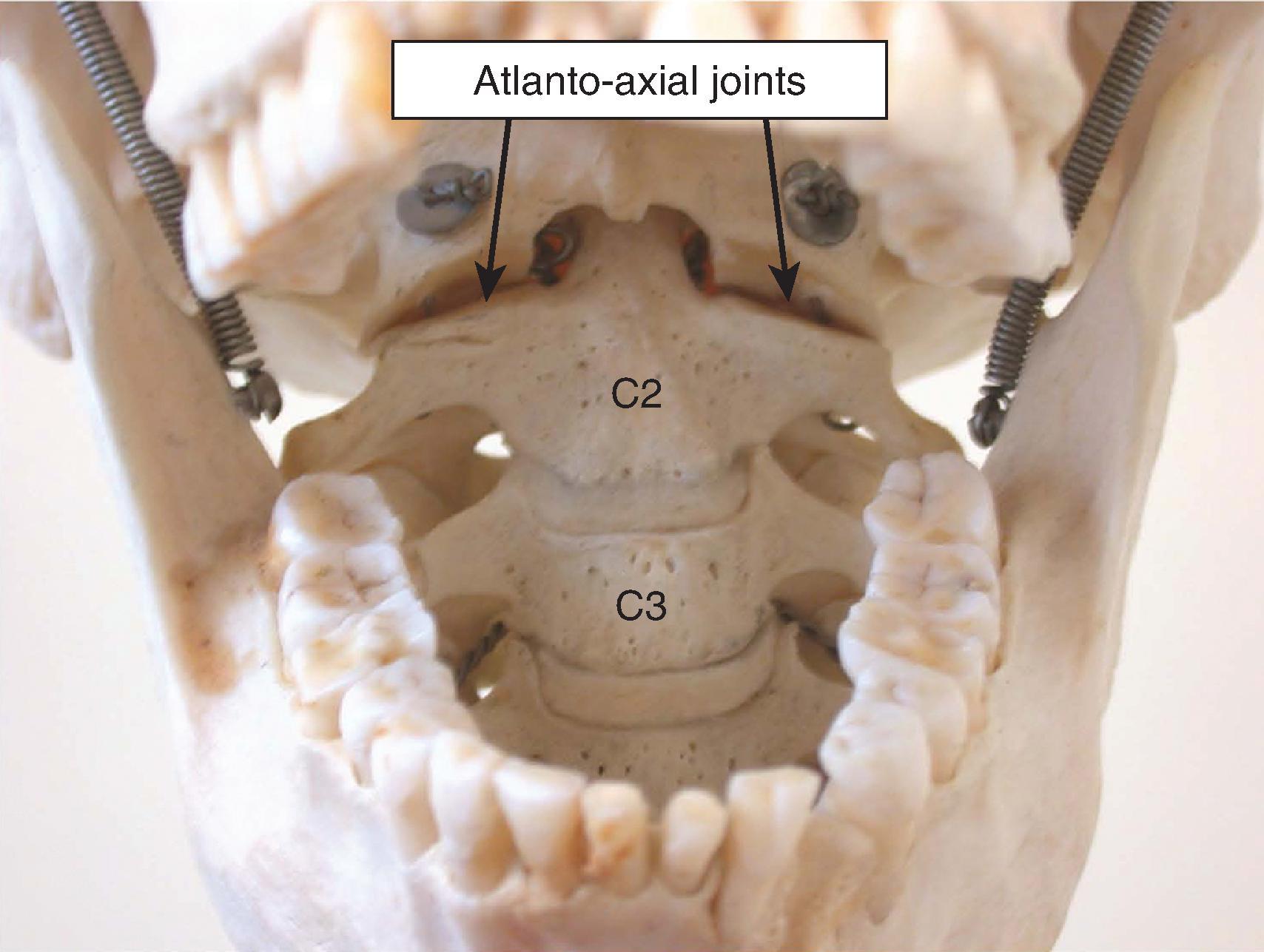
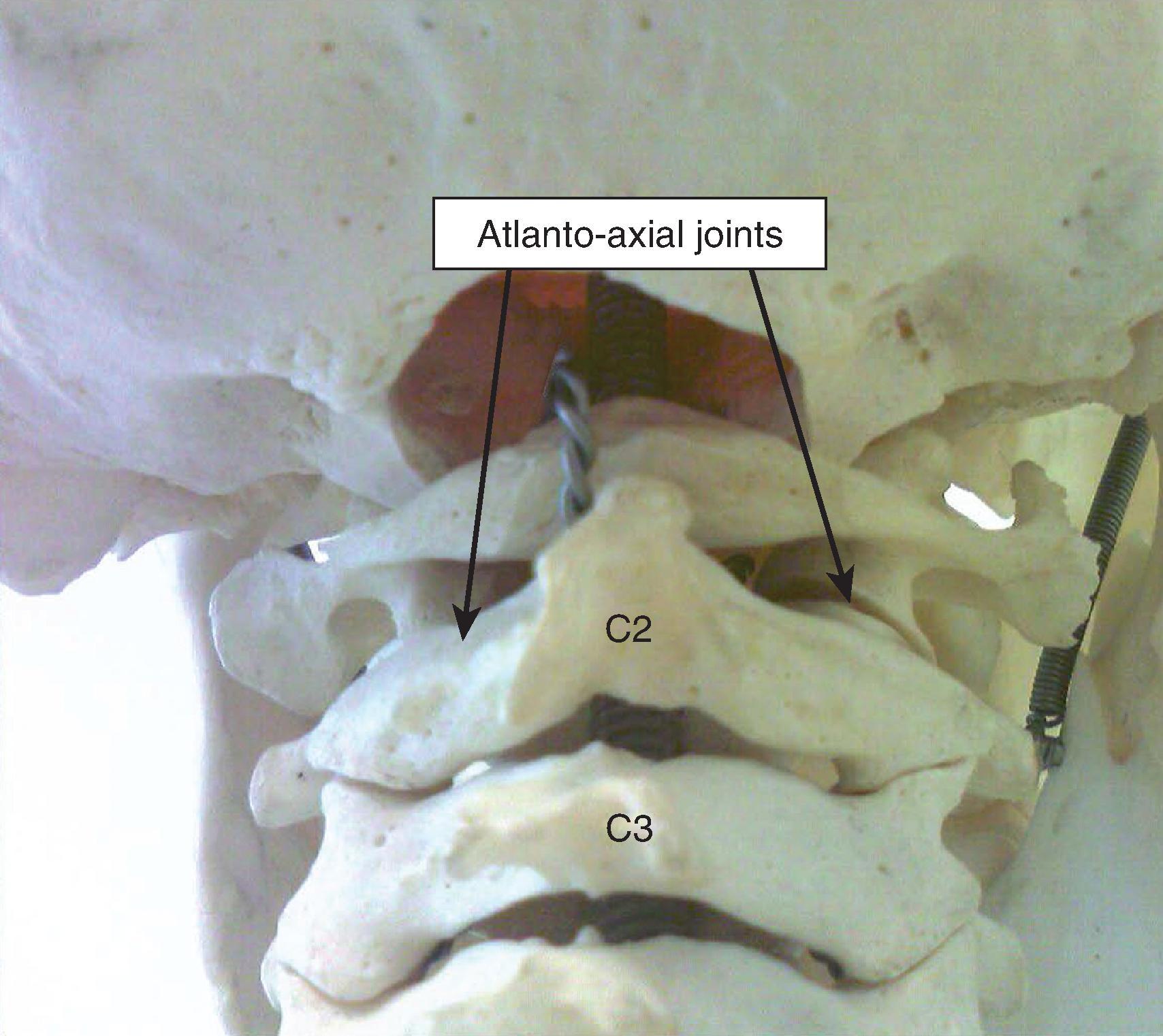
( Figs. 64.3 64.4 , previously Figs. 52.3 and 52.4)
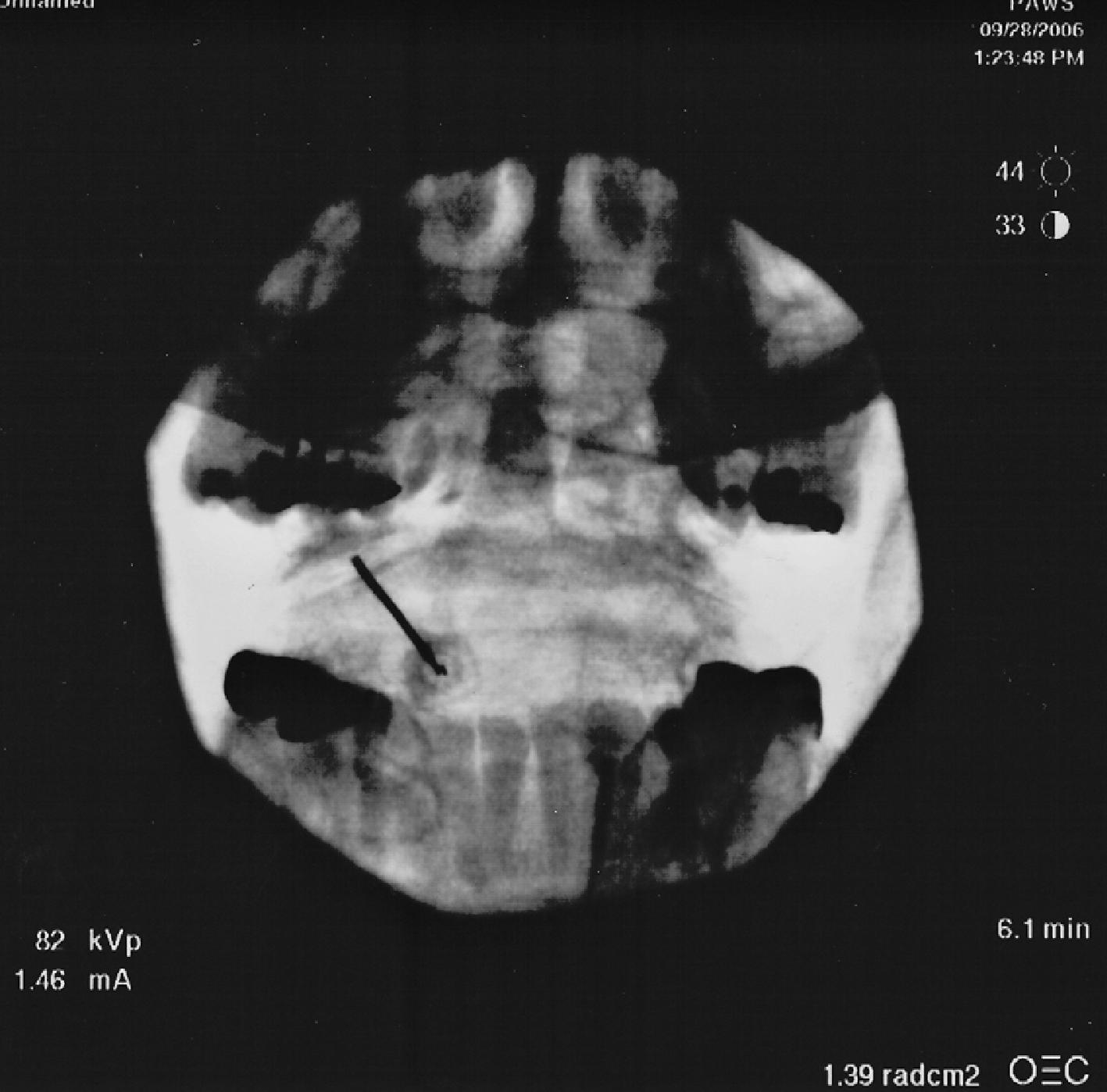
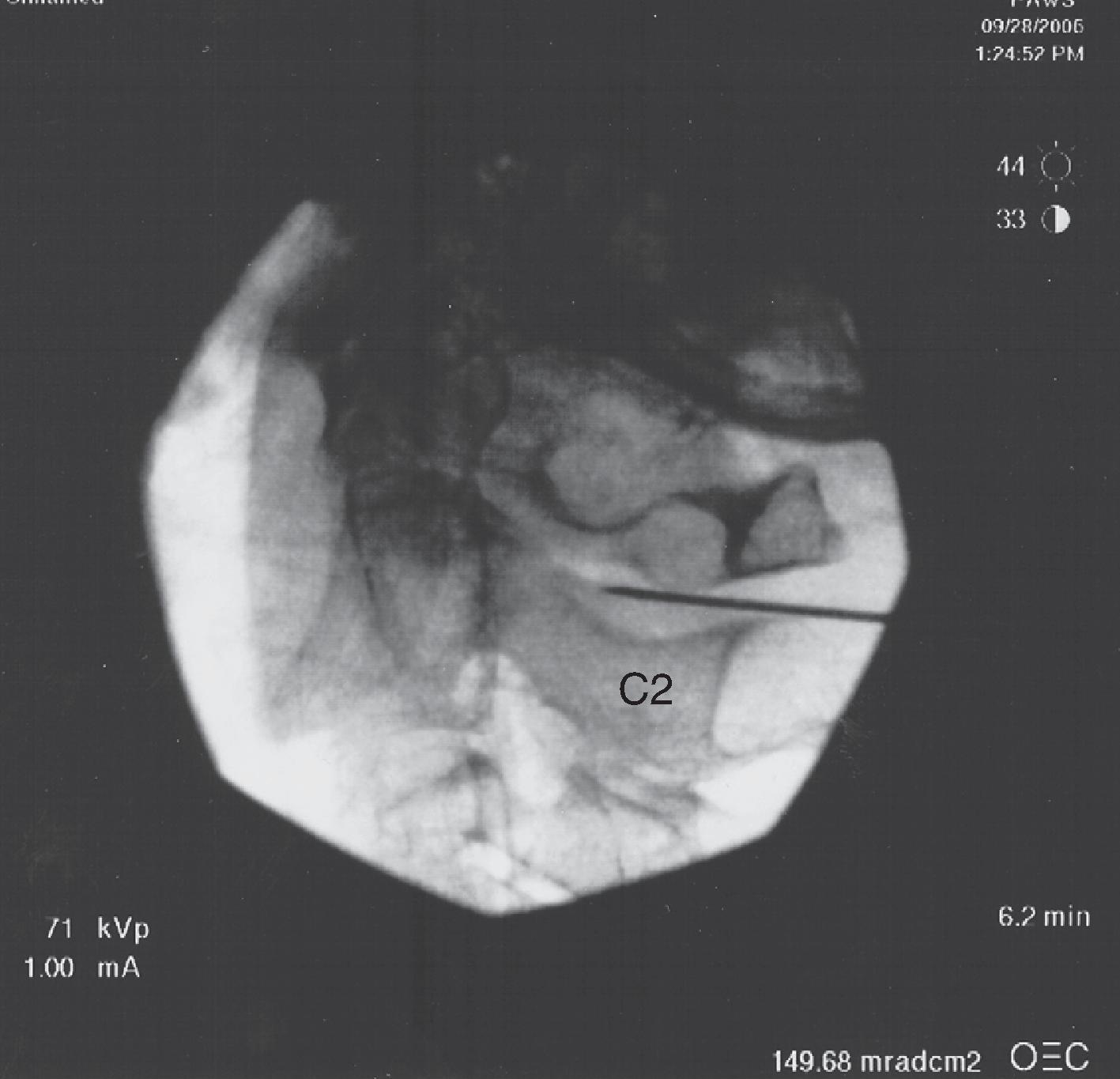
Blockade of the A-A joint requires fluoroscopic assistance to ascertain that the advancing needle does not encroach upon the critical anatomical structures such as the vertebral artery and the spinal cord. Appropriate medical history is obtained, and a targeted physical examination is performed. After establishing no bleeding problems or infectious issues and baseline vital signs taken and recorded, the patient is placed prone. Baseline vital signs are obtained and recorded. It is recommended that an intravenous peripheral line be established for prophylactic purposes. Bolsters are typically placed beneath the chest to elevate the shoulders off the procedure table, permitting the patient to flex the neck and rest the forehead upon a neurosurgical donut or pillow. After performing a careful sterile skin preparation and draping, the fluoroscopic unit is oriented in an anterior-posterior direction to identify the atlas and the foramen magnum, implementing a moderate cranial tilt of the unit until all structures are clearly visualized. The A-A joint is located lateral and inferior to both the foramen magnum and the atlas ( Fig. 64.2 ). After a local anesthetic skin wheal, an 18-gauge skin core is made using a sharp cutting needle to permit the passage of a blunt, 22-gauge, styletted Whitacre type subarachnoid needle. (A curve placed at its distal tip to allow steering of the needle once it has been advanced through the skin and subcutaneous tissues.) The needle is advanced under continuous fluoroscopic guidance, rotating the beam of the unit until the needle appears in a tunnel or “gun barrel” view, which is represented as a dot advancing toward the posterolateral aspect of the A-A joint. The needle should be directed slightly medially to avoid the vertebral artery, which is situated laterally, but not too medially, as this would potentially engage the spinal cord. Occasionally, but not always, a “popping” sensation will be appreciated as the needle traverses the joint and enters it from posterior to anterior ( Fig. 64.3 ). The fluoroscopic unit must then be rotated laterally ( Fig. 64.4 ) to confirm the needle placement at the appropriate depth between the atlas and axis. Once placement has been verified, gentle aspiration of the needle is undertaken to assess for the presence of cerebrospinal fluid (CSF) or blood. If CSF or blood is not present, a small (i.e. 1 mL) volume of radiocontrast media may be incrementally injected under real-time fluoroscopy. If the needle is indeed situated within the confines of the joint, a bilateral concavity will be demonstrated, which is indicative of an intact joint capsule. However, if the joint capsule has been ruptured, the dye may be seen to spread into the peridural space. Long acting local anesthetics (bupivacaine, ropivacaine) should not be injected. Rapid runoff of the dye may signify vascular injection and is to be guarded against, particularly if it is suspected that the needle may have entered the laterally situated vertebral artery. If this occurs, the needle should be redirected medially, re-aspiration of the needle in four quadrants undertaken, and re-injection of contrast material prior to considering injecting local anesthetics or adjuvants. Even without directly injecting into the vertebral artery (even minuscule volumes of dilute local anesthetics injected here can lead to grand mal seizures), ataxia following A-A block is not uncommon and is likely because of vascular uptake of local anesthetics in this extremely vascular region.
Diverse pain syndromes result from disorders of the cervical intervertebral discs, the facet joints (zygapophyseal, or Z-joints), or both. When confronted by individuals with headache and neck and/or shoulder pain, the clinician is compelled to seek a diagnosis based largely upon history and physical examination. The physical examination is complicated by significant variability and overlap in the innervation patterns related to the sensory distribution of the cervical medial branch nerves ( Fig. 64.5 , previously Fig. 52.5). The third occipital nerve has been implicated in chronic headache pain, primarily as attributed to cervicogenic headache. There is little doubt that syndromes related to dysfunction of the medial branch nerves of the upper cervical spine have at times been misdiagnosed as being because of tension-type and other forms of headache. Consequently, these patients who have been misdiagnosed have ultimately failed to derive analgesic benefit from medication administration and other conservative treatment measures.
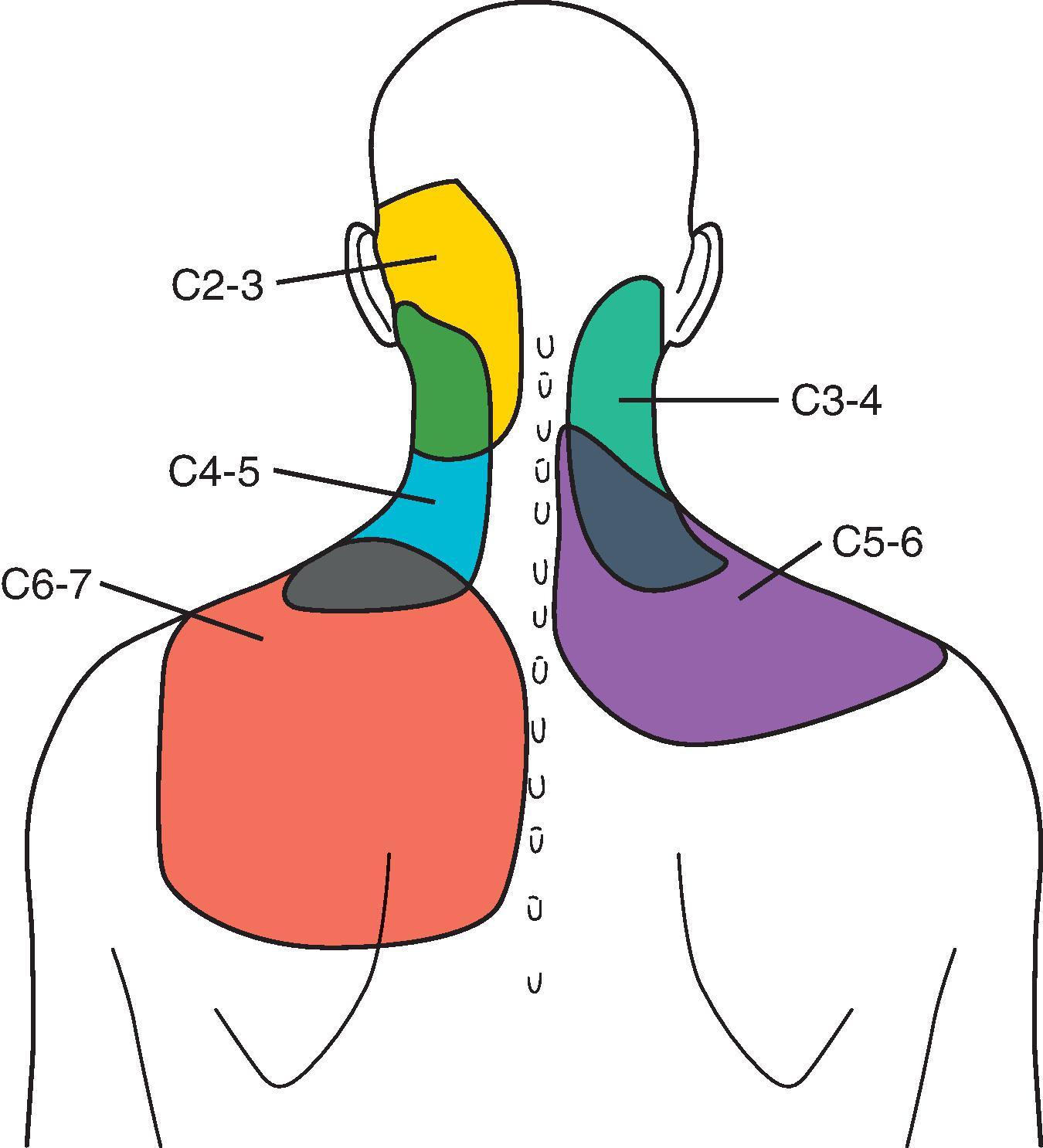
The third occipital nerve (TON) is the superficial branch of the C-3 dorsal ramus. It is the only medial branch nerve that innervates the facet joint at C2–C3 ( Figs. 64.6 – 64.8 , previously Figs. 52.6–52.8). Therefore successful blockade of the TON and the resultant block of the facet joint at C2–C3 has been associated with relief of headache pain in individuals suffering from “third occipital headache.”
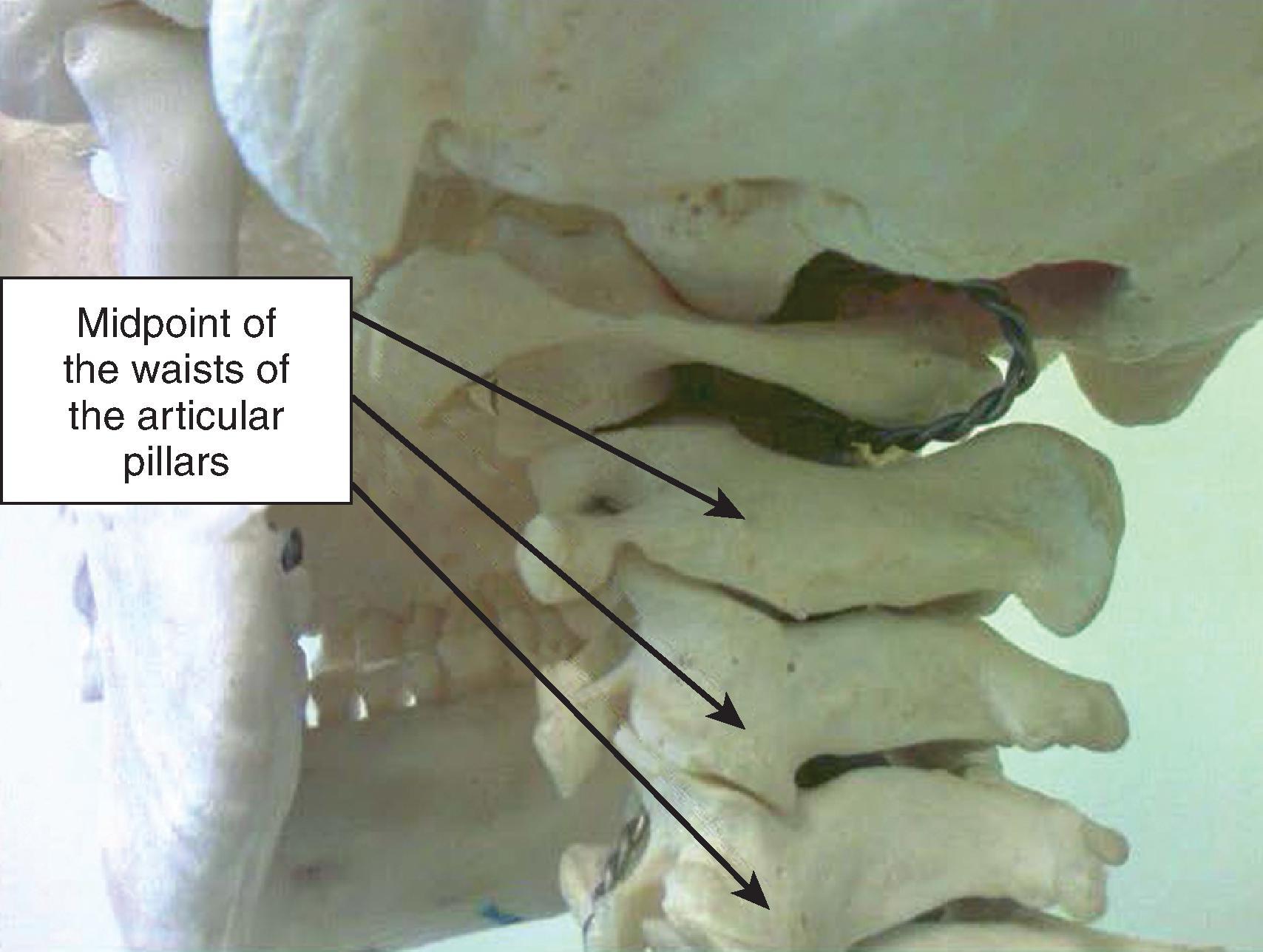
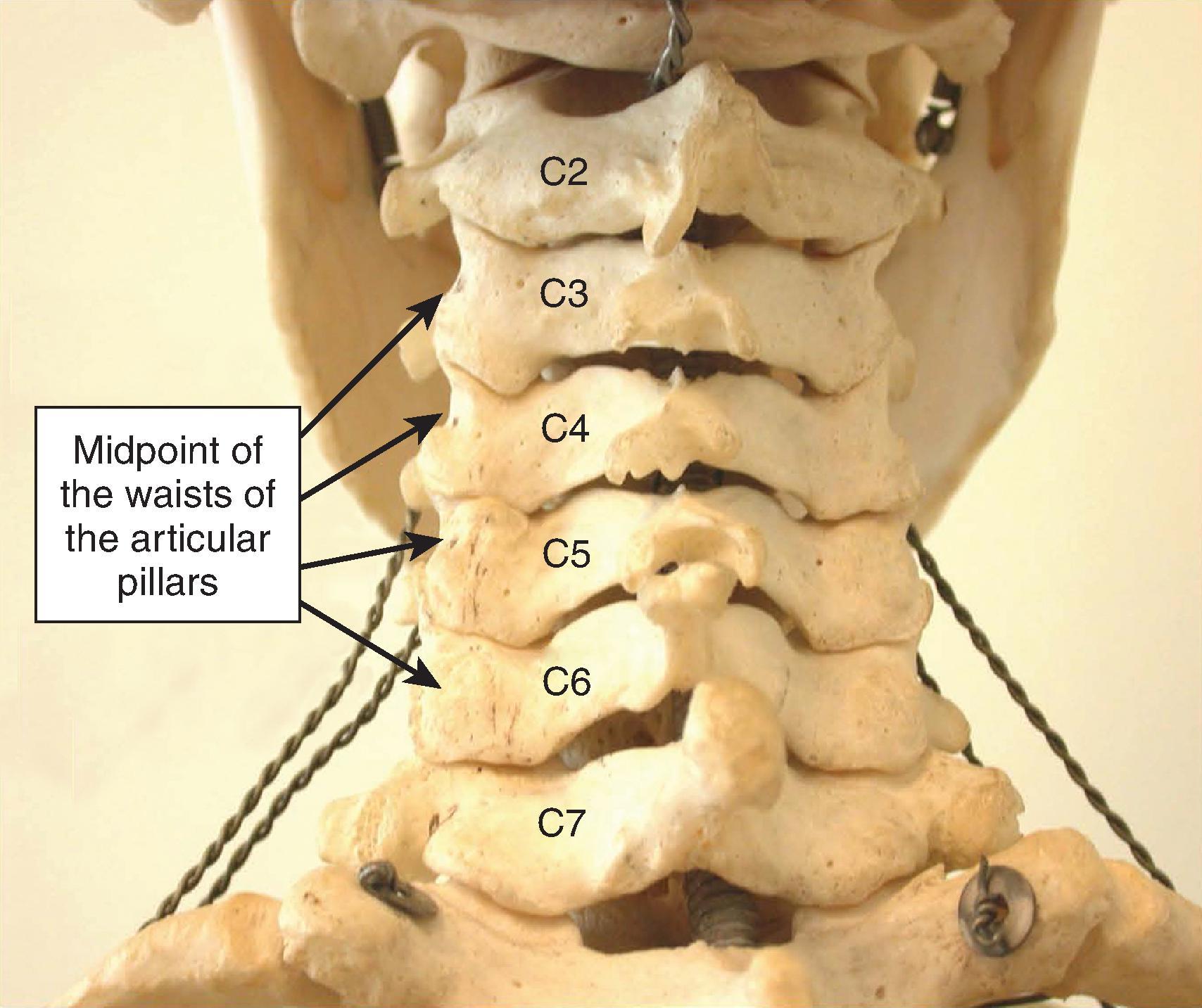
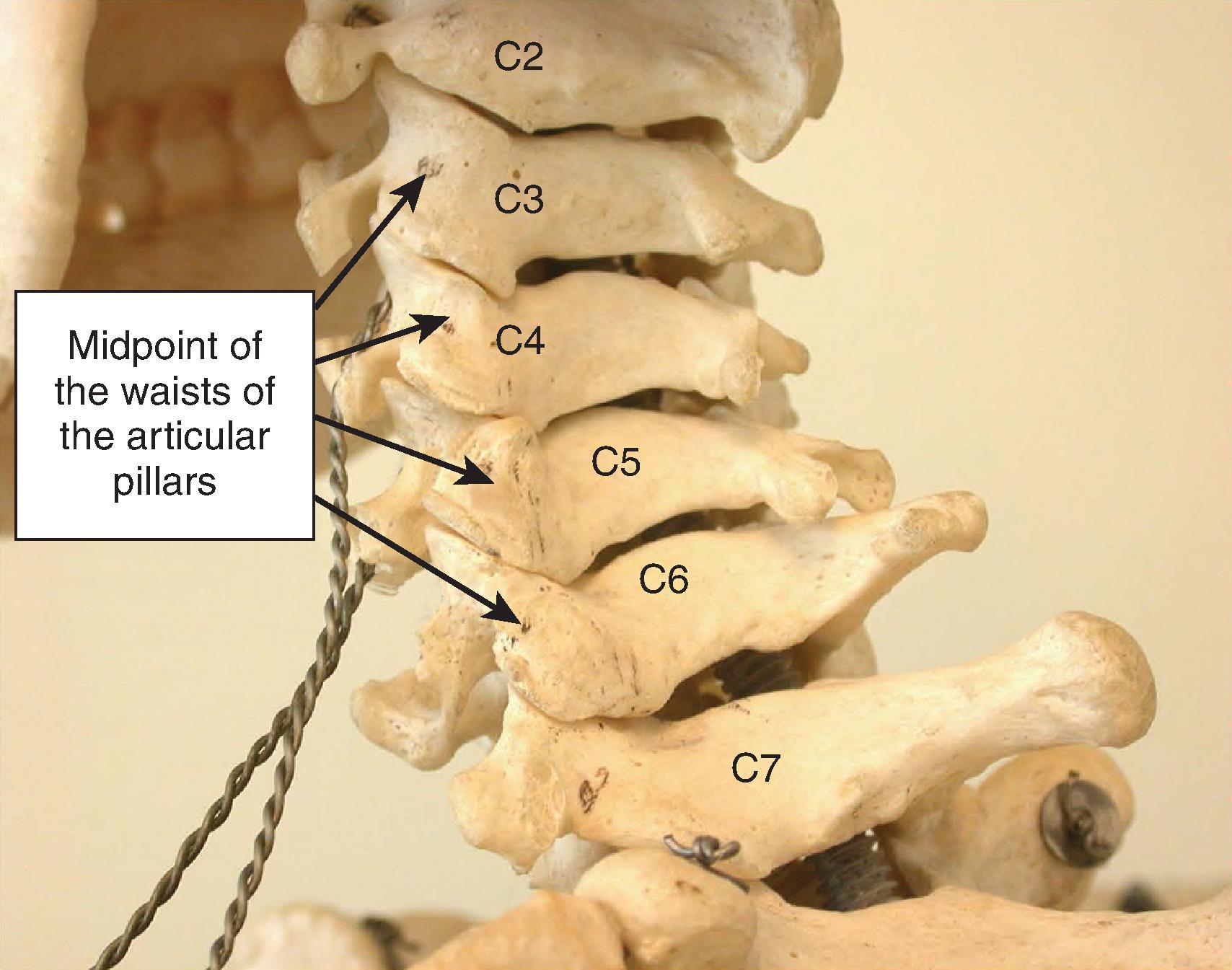
The C2–C3 joint is the first joint of the cervical spine possessing a true joint capsule and synovium, and this is the first level where an intervertebral disc and a foramen exist to accommodate the exiting C3 nerve root. In this regard, the C2–C3 joint is distinct from the atlanto-occipital (AO) (C0–C1) and atlanto-axial (AA) (C1–C2) joints superior to it. This level then represents a sort of transitional zone between the rotational joint of the neck (AA) and the lower cervical facet joints, which function not in the neck and head rotation but in neck flexion and extension.
Facet joints contain free and encapsulated nerve endings. In addition, nerves in the zygapophyseal joint (Z-joint) contain substance P and calcitonin gene-related peptide. The capsule of the Z-joint contains low threshold mechanoreceptors, mechanically sensitive nociceptors, and silent nociceptors. Each of these may respond to noxious stimulation, including moderate to severe levels of osteoarthritis, with the result being a nociceptive stimulation perceived as headache or neck pain.
The clinical anatomy of the cervical dorsal rami was described by Bogduk following dissections of five adult cadavers. He pointed out some 30 years ago that classic textbook descriptions of the cervical dorsal rami had been limited in scope and detail. While dissecting the medial branches, he was able to place wires superficially and parallel to the nerves and then perform radiographic analyses of the wires in relation to the cervical vertebral skeleton. It was noted that the semispinalis capitis muscle covers the cervical medial branches, while the lateral branches of C3-C7 lie superficial to the tendons of origin of that muscle. The TON penetrates the semispinalis capitis. The C3 dorsal ramus, a short nerve, was noted to arise from the C3 spinal nerve in the C2-C3 intervertebral foramen and then curve dorsally through the intertransverse space. At this point, the C3 dorsal ramus was noted to divide into three major branches: the two medial branches, the lateral branch, and a communicating branch. In three out of five of his specimens, the two medial branches of C3 were noted to arise from a common stem, and in the other two specimens, they had their own respective origins. The TON was the principal and constant medial branch of the C3 dorsal ramus. After arising from the C3 dorsal ramus, the TON was found to curve dorsally and medially around the superior articular pillar of the C3 vertebral body, crossing the C2-C3 Z-joint either just below the joint itself or at the joint level. The TON runs transversally medially through the fibro-adipose tissue below the obliquus inferior and dorsal to the lamina of the C2 vertebra.
A branch of the TON supplies the semispinalis capitis, which lies superficial to it. A communicating branch to the greater occipital nerve (GON) is also given off. This branch arises just above the level of the C2 spinous process. The TON then passes dorsally and pierces the semispinalis capitis and the splenius capitis, turning rostrally to pierce the trapezius, which lies over it. The more medial terminal branch supplies the skin of the rostral neck and the occiput below the external occipital protuberance. More lateral branches travel toward the mastoid process, communicating with the cutaneous rami of the GON and lesser occipital nerves (LON). Because of the transverse direction of the GON and the TON, these two nerves may be injured by parasagittal incisions made in the upper part of the neck.
The target branch for the nerve block, the TON, wraps dorsally and medially around the middle of the waist of the articular pillar of C3 (center of the bony trapezoid). As it moves more medially, the TON invests the multifidus muscle. There is a communicating branch that typically arises from the C3 dorsal ramus, running rostromedially across the posterior part of the C2–C3 Z-joint. The anatomic target for locating the nerve percutaneously is to utilize lateral fluoroscopy to identify the waistline of the articular pillars of C2 and C3 and to advance a needle or radiofrequency cannula toward the Z-joint at C2–C3. As Bogduk stated, “needles or electrodes introduced obliquely, ventromedially onto the dorsolateral aspect of the articular pillar, will rest on the medial branch. The relationship of the nerve to bone at this site is constant because the medial branches are bound to the periosteum by an investing fascia and are held against the articular pillar by tendons of the semispinalis capitis.” This target is both removed from any major arterial (vertebral artery) or other vascular structure, as well as from the exiting spinal nerve and spinal cord and is, therefore, both an appropriate target in terms of affording access to the medial branches, as well as one which provides for an approach likely to minimize unwanted trespass into non-targeted tissues.
Osteoarthritis of the C2–C3 Z-joint and trauma related to motor vehicle accidents are causes of persistent occipital or suboccipital headache pain. As there is no clear-cut clinical evaluative technique or diagnostic tool for determining patients who suffer from a headache because of disease of this joint or from neck trauma (or that mediated by the TON), it is somewhat intuitive and logical that blockade of the TON should be performed in cases of persistent headache that are unresponsive to conventional medication management.
Bogduk and Marsland conducted fluoroscopically guided TON blocks in ten consecutive patients presenting with occipital or suboccipital headache. They elected to place their needles at the lower half of the silhouette of the C2–C3 Z-joint, recognizing the landmark on X-ray as a convexity arising upwards from the concavity of the C3 articular pillar, lying horizontally opposite the level of the C2 spinous process and C2–C3 disc space ( Figs. 64.9 – 64.11 ). All procedures were performed with patients in the prone position and with a bolster beneath the upper chest and shoulders to permit head flexion forward toward the procedure table. Injected was 0.5 mL of 0.5% bupivacaine into three distinct sites; in the middle of the Z-joint at C2–C3, one injection at the lower end of the joint, and one between the first two needle placements (for bilateral blocks, the total volume was 3 mL; 1.5 mL per side). Seventy percent of patients manifest total pain relief lasting the duration of the bupivacaine following unilateral blocks. The 30% failures did not have positive responses to the bilateral blocks that were performed on their behalf. Bogduk stated that blockade of the medial branch nerves, particularly the TON, is easier for patients to tolerate than intraarticular injections since they are more easily performed and are associated with less pain during their performance than are the articular injections. Furthermore, it is apparent that local anesthetic injected into a joint may not actually stay within the joint space, potentially limiting any diagnostic information that might otherwise be derived from the procedure. Finally, markedly degenerated joints might not readily accommodate an advancing needle tip, rendering the choice of this articular approach potentially useless overall. If the ventral margin of the joint space is penetrated, there is also a distinct possibility that entrance into the epidural or subarachnoid spaces may occur, with potentially devastating consequences.
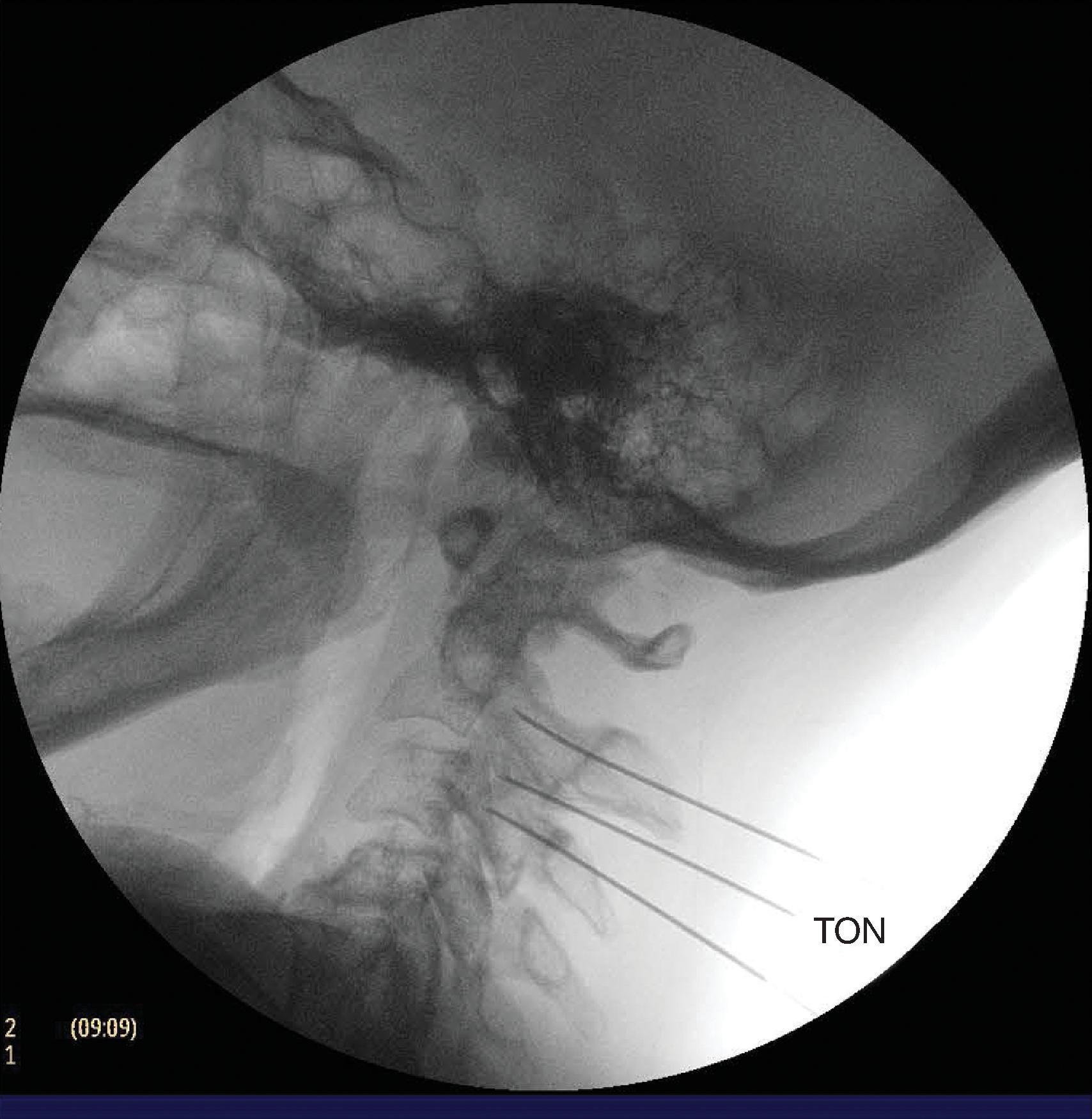
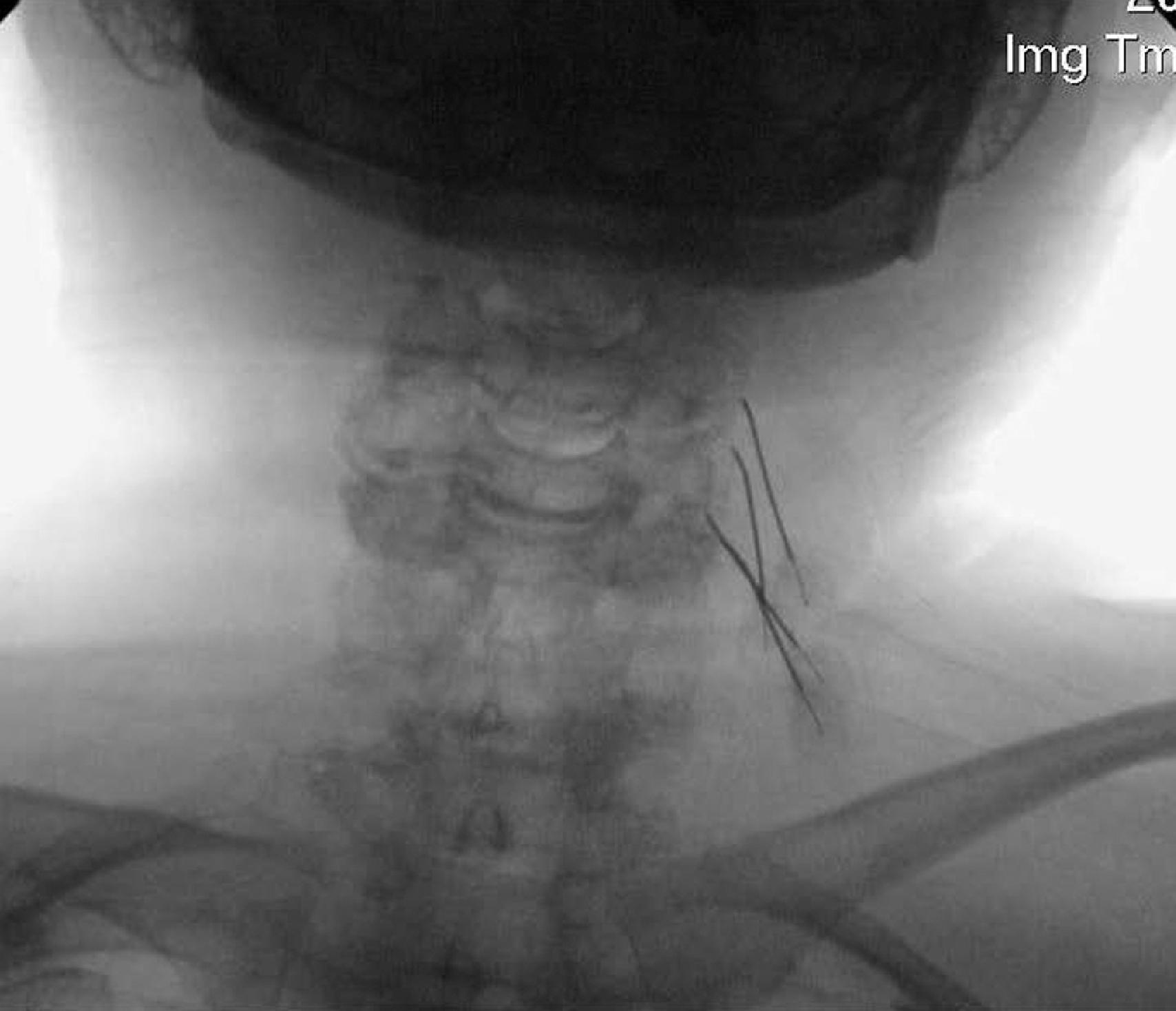
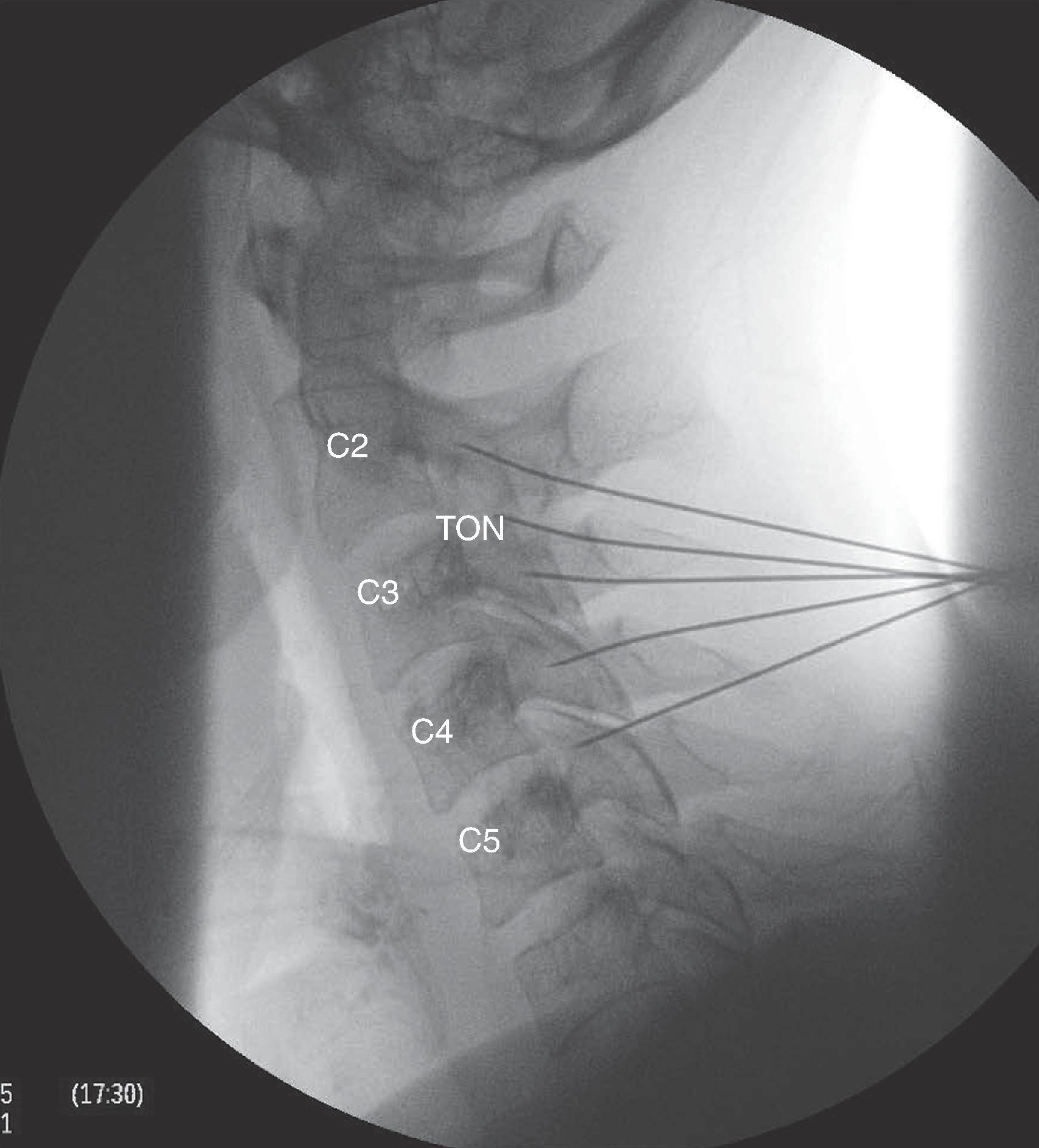
While no one knows for certain how likely it is that pain in the occipital and suboccipital area emanates from the C2–C3 Z-joint and while various studies show greatly disparate findings, several compelling attempts at determining the incidence (a measure of the risk of developing some new condition within a specified period) or prevalence (the total number of cases in the population, divided by the number of individuals in the population) need to be reviewed.
One such study on the role of the cervical zygapophyseal joint in neck pain involved 24 consecutive patients who presented with undiagnosed neck pain and had controlled diagnostic blocks with volume local anesthetic injections. For individuals with occipital or suboccipital headache and neck pain, the lower half of the lateral margin of the C2–C3 Z-joint was selected as the injection site. Complete pain relief was considered to occur if the patients, having received the bupivacaine blocks and then going home to perform their activities of daily living, noted at least 2 h of total analgesia. Failure to derive pain relief resulted in patients undergoing additional cervical medial branch blocks at contiguous levels. Nineteen out of 24 patients had positive results, with nine of these ultimately having pain isolated to the C2–C3 level. This would mean that in 47% of patients who had diagnostic block-proven cervical Z-joint pain, the TON was the nerve responsible for mediating the pain. Although this study has not been replicated, it is tempting to use this information as a general rule of thumb when approaching individuals with neck pain resulting from degenerative disease of the cervical spine and when planning nerve blocks based upon the correlation of symptoms with joint pain maps. , If it is known that in one-half of cases, the level responsible for a given pain problem is at the C2–C3 joint, then it might save time, expense, and patient discomfort to rapidly move toward ruling in or ruling out that level and the TON at the outset as part of the diagnostic workup. However, as noted below, these figures may be overreaching in terms of the actual prevalence of C2–C3 related pain. While TON block may be performed easily and simply and typically is done with little likelihood of encountering significant complications, side effects do occur commonly. Indeed, any patient presenting for this type of procedure must be duly apprised that successful blockade of the TON (or GON) will likely result in the temporary development of ataxia and some gait unsteadiness. For this reason, bilateral blocks at these levels should likely either be staggered, or else the benefit/risk ratio must be significant enough that performing bilateral blocks is warranted.
The subject of joint pain maps merits special mention, as noted above ( Fig. 64.5 , previously Fig. 52.5). Multiple attempts have been made to delineate the specific cutaneous area of sensation, and hence pain, invested by each respective facet joint and medial branch. In the report by Fukui et al. the site of Z-joint intraarticular injection and electrical stimulation (selected cases) was chosen based upon any focal paraspinal tenderness. They observed that with injections performed at C2–C3 ( n = 14), symptoms were referable to the upper posterior cervical region (64%), the occipital region (50%), and/or the upper posterolateral cervical region (50%). Windsor et al. electrically stimulated the cervical medial branches, including the TON in nine patients suffering from chronic neck pain. They used the lateral mid-point of the C2–C3 Z-joint to indicate the location of the TON. Relatively reproducible referral patterns were identified for the TON nerve distribution as well as for the other medial branch nerves studied.
However, what is immediately obvious when reviewing these studies is that there is considerable overlap in the areas served by each of the respective segments, much more so than that observed with attempts at mapping spinal nerve dermatome distributions. This produces a diagnostic conundrum, as it is entirely conceivable when approaching cervical spine pain that even perfectly performed techniques, using standardized and accepted anatomical landmarks, may result in failures to derive anti-nociception with the resultant confusion on behalf of the patient and treating physician.
Since both the intervertebral disc and facet joint are fairly equivalently represented as sources of neck pain (approximately 40% each as sources of neck pain, according to two separate studies), a missed diagnosis might lead a pain physician in the wrong direction when seeking to provide pain relief to a given individual. , Mapping studies may help pinpoint discrete areas of pain referral sources that are then amenable to local anesthetic blockade and/or radiofrequency lesioning techniques. In one such study, joint maps were created by distending the respective joint capsules at segments from C2–C3 to C6–C7. This was done by sequential injections of contrast media, which could be subsequently identified using fluoroscopy. Each joint was noted to produce a characteristic, distinguishable pain pattern from which pain charts could be constructed ( Fig. 64.5 , previously Fig. 52.5). Although only four total subjects comprised this evaluation, that number is not too disparate from the original small group of subjects selected to develop the original dermatome charts in neurologically impaired individuals, which has persisted, largely unchallenged, for more than six decades. In 10 subjects who received injections based upon maps such as those derived and described above, 90% had complete concordance of the predicted pain level and the positive response to the blocks. The C3–C4, C4–C5, and C5–C6 levels were most commonly affected, with only 10% (1/10) of patients having pain that was documented to result from processes occurring at the C2–C3 (TON) level. Therefore these percentages are less indicative of the possibility of the C2–C3 level being primarily involved in head and neck pain than they are of alternative levels lower in the cervical spine. However, a study by Barnsley and Bogduk from 1993 demonstrated that, following cervical medial branch injections performed in 16 patients suffering from chronic neck pain, 33% (3/9) patients who had complete pain relief were patients for whom the TON was treated. Thus it remains unclear how likely the TON is to be implicated in individuals suffering from chronic head and neck pain. The closest studies performed to identify the prevalence of TON induced headache and neck pain may have been those performed by Lord and Barnsley et al. , In the first study, 100 consecutive patients underwent double blind, controlled diagnostic blocks of the TON. On two separate occasions, the nerve was blocked using either lidocaine or bupivacaine. The diagnosis of TON nerve involvement was only made if the double diagnostic blocks both relieved the symptoms, with the bupivacaine injection-induced pain relief outlasting that provided by the lidocaine. The prevalence of TON headache in chronic neck pain following whiplash was found to be 27%, while the prevalence of TON headache after whiplash was noted to be 38%.
In the second study, 50 consecutive patients with chronic neck pain and whiplash injury underwent double blind, controlled diagnostic medial branch blocks using 0.5 mL lidocaine (2%) or bupivacaine (0.5%) randomly. In 12/27 patients (44%), the source of symptoms was identified as being isolated primarily to the C2–C3 Z-joint.
These findings corroborate the impression that although there may be substantial overlap in cutaneous innervations of the central and peripheral nervous systems, these joint maps are essential tools to assist one in determining the appropriate approach to a given pain process in any individual. They also demonstrate variability in assessing the relative incidence and relative prevalence of C2–C3 Z-joint pain, depending upon technique of assessment and use of varying provocation maneuvers to assess the joint and the medial branch nerve (TON).
The TON block is useful in both the diagnostic as well as the therapeutic phase of treating cervicogenic headaches. Evidence of efficacy for both local anesthetic blocks as well as for radiofrequency ablation (RFA) of the cervical medial branches has accrued over the past several decades. Nevertheless, it is only relatively recently that the use of medial branch nerve blocking techniques and RFA techniques have received scientific support in the literature. Indeed, two separate attempts at meta-analysis have shown somewhat disparate results. The first such paper, published in 2001, suggested that radiofrequency neurotomy used for treating pain from the cervical Z-joints after flexion-extension injury was only supported by limited scientific data. However, a mere six total studies satisfied the authors’ criteria for inclusion; thus it is entirely possible that the data suffer lack of suitable cohort studies to make a true assessment of its validity. The second review performed in 2007 liberalized the inclusion criteria somewhat and found that the support for medial branch cervical block was moderate (Level III), as was the support for cervical medial branch neurotomy. Here, the authors relied upon the Agency for Healthcare Research and Quality criteria, which included some non-randomized trials. They also incorporated studies from the Cochrane Musculoskeletal Review Group, which were randomized trials. One of the important points noted was that the evidence for performing cervical intraarticular facet joint injections was limited both for short-term as well as for long-term analgesia efficacy. This corroborates Dr. Bogduk’s earlier assertions that not only are medial branch techniques more likely to target the real source of pain associated with cervical degenerative facet conditions but also that articular procedures have an inherently high failure rate since there is no guarantee that injected local anesthetic will remain in the confines of the joint (see above).
The rationale for blocking the TON is two-fold:
To provide a diagnostic evaluation of the C2-C3 facet joint as the source of pain in the occipital and suboccipital areas.
To provide an indication as to whether or not neuroablative techniques applied over that nerve might be fruitful in treating pain on a long-term basis.
The present authors suggest performing double diagnostic blocks using 0.5 mL of local anesthetic solutions, typically 0.5% ropivacaine plain, before undertaking neurotomy of the TON. Ropivacaine is used for two major reasons. It has intrinsic vasoconstrictor properties, and therefore no epinephrine is necessary. It also has a cardiovascular safety profile superior to bupivacaine and poses a less theoretical risk for use in outpatient procedures. Unintentional injection into vascular structures, including the vertebral artery, is less likely to result in serious morbidity when ropivacaine is used, in contradistinction to bupivacaine. Ropivacaine also provides a duration of analgesia that exceeds that provided by shorter acting agents such as lidocaine or mepivacaine. Regarding assessing efficacy, it is likely that longer acting amino-amide local anesthetics may provide greater information than shorter acting drugs since the effect of the shorter acting drugs may be so fleeting as to provide confusing or inexact clinical information. However, whether or not this is true remains the subject of some clinical controversy.
Double diagnostic blocks have been described for assessing the efficacy of cervical medial branch blocks. Barnsley et al. compared single versus double diagnostic blocks in 55 adult patients having neck pain for longer than three months. They randomly used 0.5 mL of either 0.5% bupivacaine or 2% lidocaine. The duration of analgesia was assessed in a double blind fashion. They found that the false positive rate (a test result that is read as positive but actually is negative; a test that shows evidence of a disease when it is not present) of single-blocks was 27% (16/60). They also found that the most common positive levels were at C2–C3 and C5–C6. Lord et al. found that comparative blocks of the medial branches using either lidocaine, bupivacaine, or normal saline in randomized, double blind, placebo-controlled fashion in 50 patients had a specificity (the statistical probability that an individual who does not have the particular disease being tested for will be correctly identified as negative, expressed as the proportion of true negative results to the total of true negative and false positive results) (TN/TN + FP) of 88%, but only marginal sensitivity (the proportion of individuals in a population that will be correctly identified when administered a test designed to detect a particular disease, calculated as the number of true positive results divided by the number of true positive and false negative results) (TP/TP + FN) (54%). Hence some of the 46% of patients who are not placebo responders would incorrectly be labeled as placebo responders if diagnoses were based solely upon comparative blocks.
Slipman et al. retrospectively reviewed 18 patients with chronic persistent daily headaches lasting a mean of 34 months following whiplash injury who underwent intraarticular C2–C3 facet joint injections. They noted that in 61% of cases, headache frequency diminished from daily to less than three headaches/week. Although this work is retrospective, the results nevertheless demonstrated further rationale for targeting the TON in chronic headache conditions refractory to conventional conservative care and management. Furthermore, since the injections were articular and not at the medial branch (TON), the information gleaned from this report may not be useful in determining candidacy for radiofrequency neurotomy.
C2–C3 medial branch (TON) procedures are usually performed with the patient in the prone position using continual live fluoroscopic guidance throughout the injection phase ( Figs. 64.9 – 64.11 , previously Figs. 52.9–52.11). A bolster is placed beneath the shoulders and chest to elevate the thorax off of the table and to permit gentle head and neck flexion forward. An intravenous cannula is placed, and vital signs are monitored using standard American Society of Anesthesiologists (ASA) basic monitors. After performing a sterile skin preparation, scout films are obtained of the neck, seeking to identify the scalloped margins of the lateral vertebral bodies. Then, skin wheals are raised over the intended target(s) using a hypodermic needle and 1–3 mL of lidocaine. Using short-beveled, 22-gauge, 2.5–3.5 inch needles, the targeted lateral scalloped margins of the vertebral bodies are advanced upon until bony contact is made. At this point, the fluoroscopy unit is rotated laterally to assess the relationship of the advancing needle tip to the TON target in the center of the C2–C3 Z-joint (see above). The needle tip must be recessed posteriorly away from the C2–C3 intervertebral foramen as well as from the known location of the vertebral artery. If no bony contact has been made and 2 cm of the needle has been placed into the skin, then a reassessment of the approach and direction is undertaken while still in the A-P fluoroscopy mode. Once the needle is appropriately seated on the bone at the target ( Fig. 64.4 , previously Fig. 52.4), the A-P view is once again undertaken to verify that the needle(s) is in the correct position vis-à-vis the lateral vertebral body margin.
Ultrasound guided approaches are rapidly gaining in popularity for all forms of interventional pain procedures, but most clinicians have not yet reached the level of sophistication to supplant fluoroscopy use for this particular procedure. At this point, aspiration tests are performed to verify the absence of blood or cerebrospinal fluid, and the patient is queried to ascertain that no paresthesia has been elicited. If there are none and vital signs remain stable, 0.5 mL of 0.5% ropivacaine is injected. No glucocorticoid is added to the solution, as Manchikanti et al. have demonstrated little if any value of adding steroid to the blocks. While this one study demonstrated no added benefit of corticosteroid use in diagnostic/therapeutic cervical medial branch injection versus not using steroids, many clinicians continue to employ them in daily practice. It can only be stated that this is an area of some controversy, and if the risk-benefit ratio favors using steroids in a given individual suspected of having an inflammatory component to their pain, then there may be little harm in employing them in judicious doses. After completing the injection phase, the needle(s) is cleared and withdrawn, and a sterile dressing is applied over the injection site. The patient should be observed for no less than 30 min as it is quite common that most patients will become ataxic or unsteady of gait following successfully performed procedures. Discharge instructions should be clear and precisely instruct patients to seek emergency medical care if they develop any delayed onset side effects or complications from the procedure, as unlikely as that may be.
In selected patients, radiofrequency of the TON may be considered for long-term therapeutic benefit. In a study published in 1995, Lord et al. demonstrated the efficacy of performing RFA of the TON in only 40% of patients (4/10), with only three having long-lasting pain relief. They used 10 cm needles with either 4 mm or 6 mm exposed tips. No stimulation test was performed to assure concordance of needle placement with the nerve. Instead, the authors relied solely upon fluoroscopic anatomic cannula placement. The mean duration of the C2–C3 neurotomy procedure was stated to have been 1.5 h. The rather meager success rate was in sharp contrast to the 70% success they noted for lower cervical medial branch procedures. The authors stated that radiofrequency of the cervical medial branches “carries a high rate of technical failure.” In 1996 Lord et al. suggested that RFA of the cervical medial branches, performed in 24 patients with a median duration of pain of 34 months following motor vehicle accidents, provided a median duration of analgesia persisting 263 days. This contrasted sharply with the median analgesia of eight days in a control group of patients. However, they excluded individuals with C2–C3 Z-joint pain based upon their rather dismal results from the previous study noted above. In a subsequent study published by the same group of investigators, complete pain relief was found in 71% of 28 patients following a single RF procedure, persisting a mean duration of 219 days. When failures were excluded from consideration, the mean duration extended out to 422 days (60 weeks). Again, excluded from the study were individuals suffering from TON-mediated C2–C3 pain. Govind et al. in 2003 used three large gauge electrodes to perform RFA procedures of the TON. Following controlled diagnostic blocks, 51 nerves in 40 patients were treated with RFA. Eighty-eight percent (43/49) achieved successful outcomes using this approach, with a median duration of 297 days (42 weeks). Side effects included ataxia, stated to be “slight” numbness, and temporary dysesthesias. Their improved success was attributed to the use of three needles, the use of Ray electrodes instead of SMK electrodes (smaller), and the assurance that each of the three lesions was made at a distance no greater than one electrode width from an adjacent lesion.
Cohen found that the only factor predicting the success of RFA, defined as at least 50% pain reduction lasting at least six months, was paraspinal tenderness. Although the authors state that C2–C3 pain was included in this analysis, they never indicated how many individuals were treated this way nor what the success rate was for TON RFA.
Greater and LON Blockade ( Figs. 64.12 and 64.13 , previously Figs. 52.13 and 52.14, and Fig. 64.14 ).
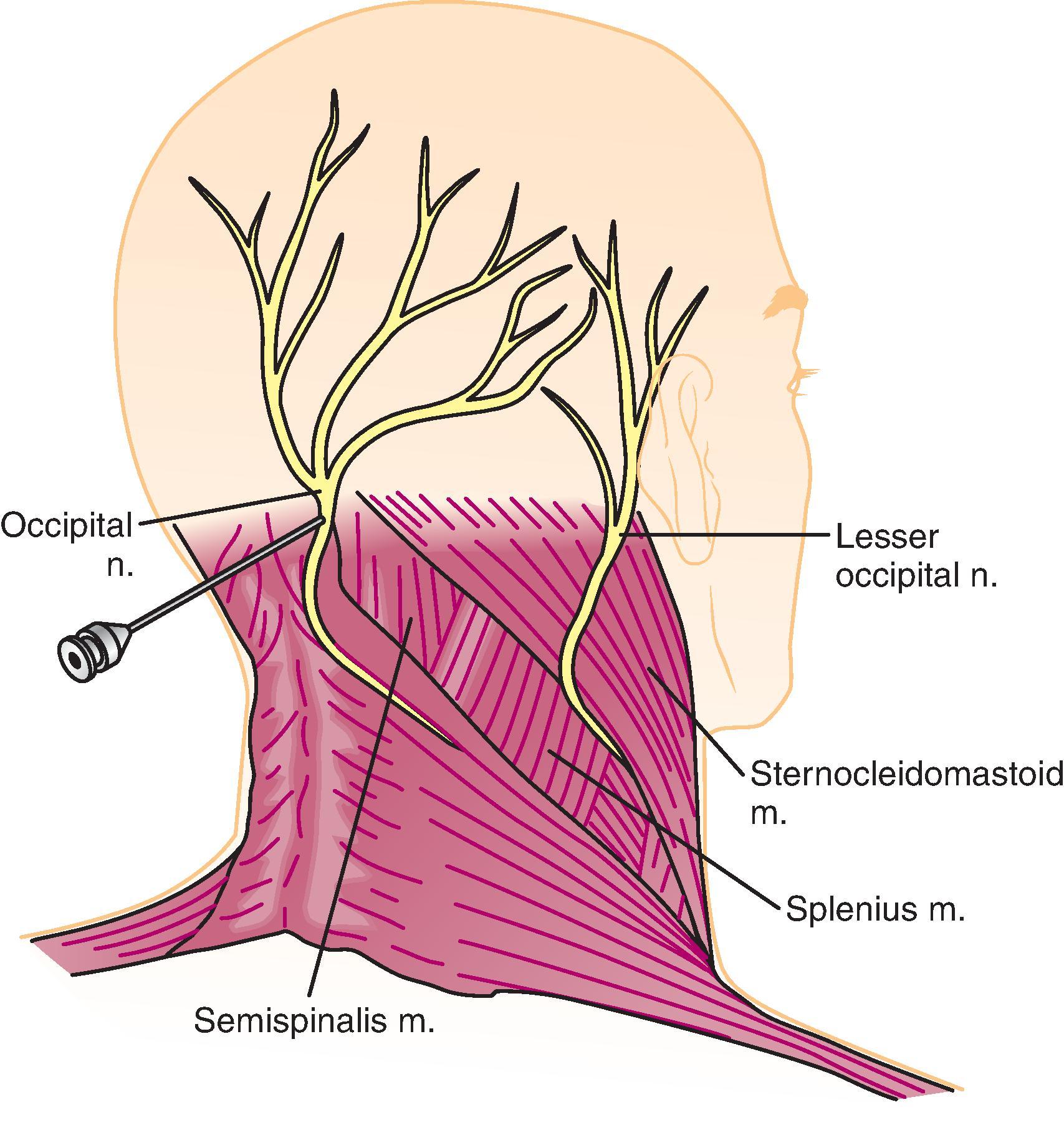
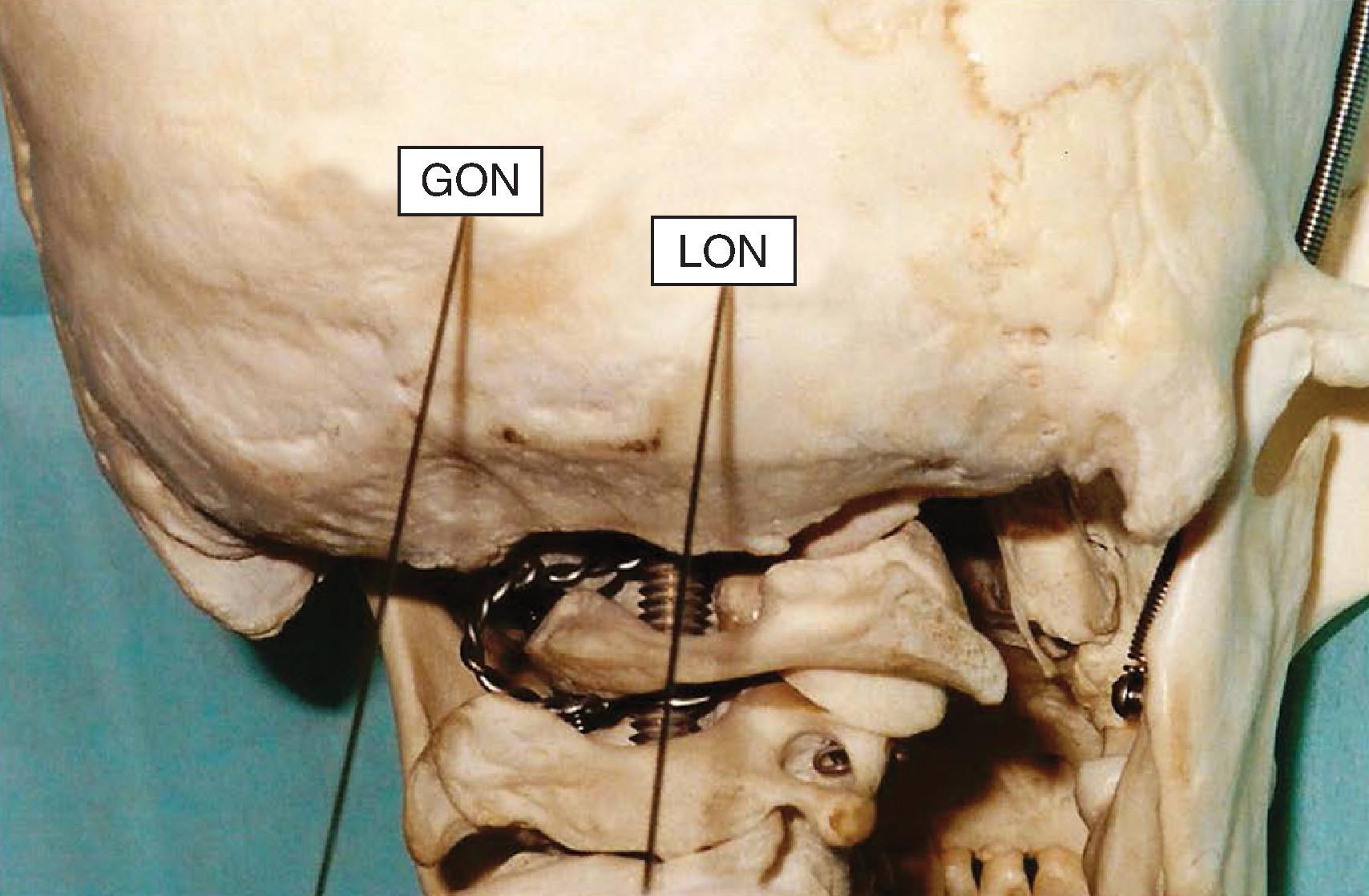
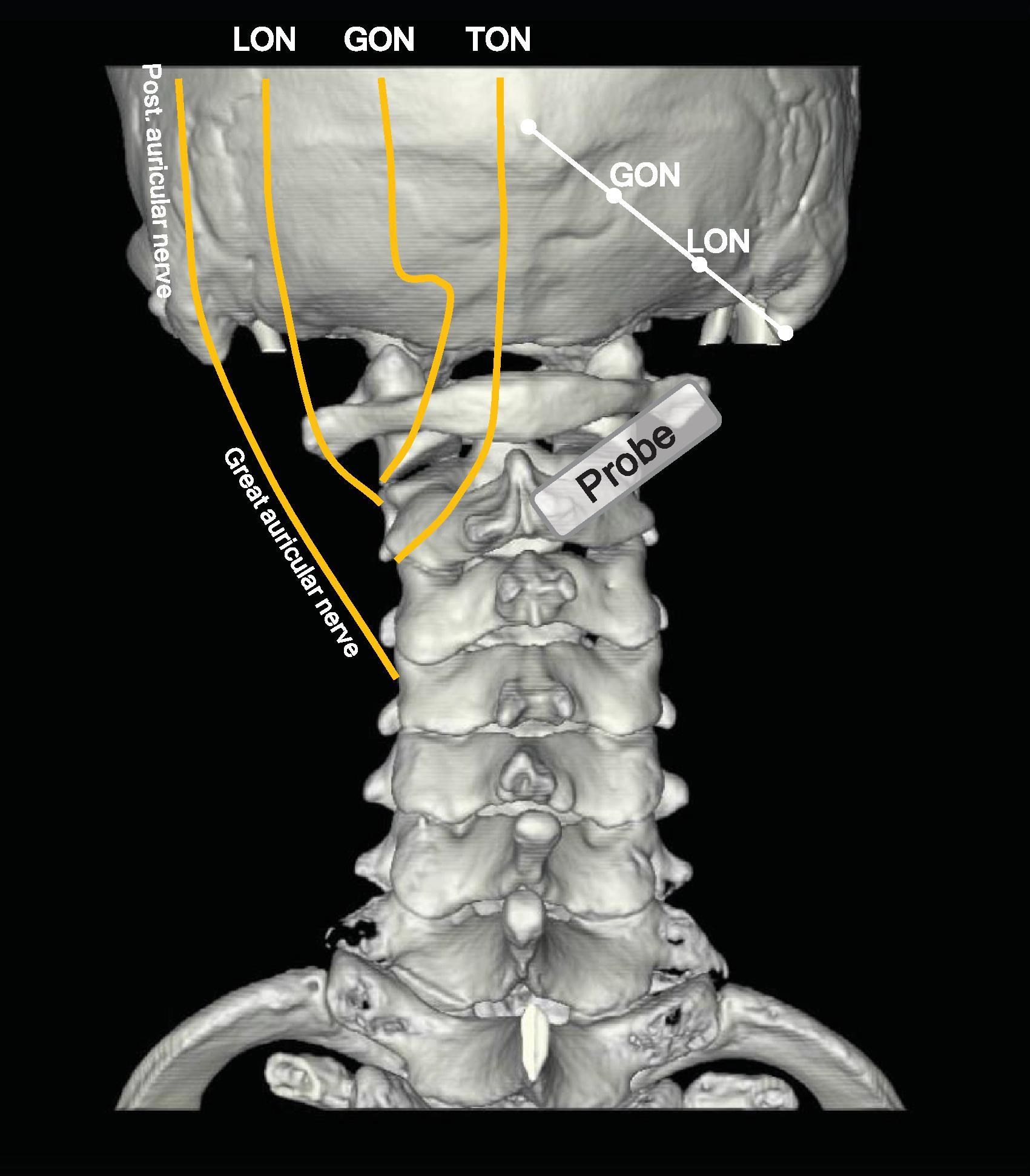
The GON arises from the dorsal primary rami of C2, with occasional contributions from C3. The nerve penetrates the fascia inferior to the superior nuchal crest, where it runs alongside the occipital artery for a variable distance. The sensory area innervated by the nerve includes the medial portion of the posterior scalp, with radiation ventrally up to the vertex. The LON arises from the ventral primary rami of C2 and C3 and passes superiorly and laterally from the occiput to the lateral edge of the sternocleidomastoid muscle. Here the nerve divides into cutaneous branches that innervate the lateral portion of the posterior scalp and the cephalad surface of the ear pinna. Along with the great auricular nerve, the GON and LON provide most sensory afferent information for the occipital area and are responsible for transmitting information derived from C2-C3 facet joint derangements to the referral area described.
Occipital nerve blocks have become an increasingly popular method of managing headaches of diverse etiologies, even though the scientific support for doing so is limited. GON blocks have been shown to be ineffective for chronic tension-type headache when prilocaine and dexamethasone were used in a group of 15 patients. They have been used with various degrees of success for postconcussive headaches (80% successful in then patients), atypical orofacial pain, and especially for migraine headaches, when they are often combined with trigger point injections, or supraorbital nerve blocks, in both cases affording a very high degree of success for ameliorating pain and brush allodynia. A novel use of GON block has been in the successful treatment of patients with abnormal head movements who also suffered from tinnitus and dizziness associated with a previous history of trauma. Further, the injection of botulinum toxin type A (50 units) was suggested to be more effective than the use of bupivacaine in reducing short-term and long-term pain in patients with chronic headache in the occipital area. Although often, the diagnosis of headache because of occipital neuralgia is not too difficult to make, there are cases of refractory headache that require advanced evaluation techniques. Although some suggest performing computed tomography (CT)-guided C2–C3 nerve blocks as a prelude to considering patients who may be candidates for percutaneous rhizotomy, fluoroscopically guided techniques of C2–C3 nerve block have been used and have precluded the requirement to seek more advanced imaging for guidance ( Figs. 64.8 and 64.9 ). Besides, ultrasonography has recently become a more popular image modality for the occipital nerve block at the upper part of the posterior neck, which is named the proximal approach.
Some have erroneously described occipital nerve blocks as merely a field block of local anesthetic and steroid layered somewhere in the posterior part of the occiput, without regard to anatomic landmarks or consequences of errantly placed medications. Indeed, there are cases of sudden unconsciousness reported following LON block, some resulting from occipital artery injection and at least one the result of unintentionally injecting local anesthetic into a previous bone defect from a craniotomy. In addition, it is possible that unconsciousness might occur after the GON block has been made too far inferiorly toward the foramen magnum. Additionally, if practitioners are not careful and discriminating in their choices of frequency of GON block and use judicious doses of agents, including corticosteroids, additional complications like the development of Cushing syndrome may result. Our technique of blockade of the occipital nerves is to perform the procedure with the patient in the sitting position, with the forehead forward, resting on either a Mayo stand, the edge of a padded table, or on a gurney. If possible, the occipital artery is palpated at the superior nuchal ridge. Using ultrasound guidance may help identify the artery, which is often not robust or bounding and, subsequently, not always readily discernible as a distinct structure. As it is virtually impossible to completely disinfect the scalp injection site, we utilize alcohol wipes or a Betadine-soaked pledget to soak the area with a disinfectant prior to inserting the needle, without expectations of complete asepsis. Next, we insert a fine-gauge (25-gauge, 1.5 inch) cutting needle immediately medial to the artery and advance it perpendicular to the skin until the needle tip touches the periosteum ( Fig. 64.14 ). Once the occipital bone has been contacted this way, the needle is retracted about 1 mm and is redirected slightly cephalad. After gently aspirating, 5 mL of local anesthetic (0.5% bupivacaine or ropivacaine) with 4 mg of dexamethasone or 6 mg of betamethasone is injected in a fanlike manner, taking care not to direct the needle too far medially toward the foramen magnum. The LON may be blocked, as can the greater auricular nerve, by removing the needle and placing it into the skin about 3–4 cm lateral to the entry point for GON block, while also directing it inferiorly instead of superiorly as for GON block ( Fig. 64.14 ). After gentle aspiration, 5 mL of the same combination of local anesthetic with or without corticosteroid as noted previously may be injected, again in a fanlike distribution, to block the nerve. After completing GON and LON blocks, it is important to gently massage the tissues of the scalp to assist in the spread of the agents while maintaining pressure over the injection site(s). This will minimize ecchymosis or hematoma formation from this highly vascular area. Often, an ice pack is applied for 20–30 min post-procedure to further minimize swelling and inhibit vascular absorption of the local anesthetic agents, particularly if bilaterally blocks have been performed.
Become a Clinical Tree membership for Full access and enjoy Unlimited articles
If you are a member. Log in here